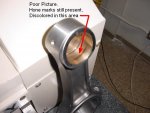We pulled apart two pistons on our last run at Bonneville. The engine had many quarter passes, dynos, a sled pull, and 3 LSR passes before the pistons quit. So there was a good amount of abuse put to them.
I put the rods on a CMM machine, and found that even the damaged cylinders had acceptable eye to eye length. 6 were less than .0005" from original spec, and 2 were less than .002"
One rod twisted slightly on a damaged piston cylinder, which most likely happened after the piston came apart and the wrist pit hit the bottom the of the piston.
A stripe of burnishing was appearing in the little end bushings about .2" wide and 90° long on the pressure side. It is 1/2 way between the center oiling groove and the outside, so it's an oiling issue. Stock rods show this as well. Whether it would ever get to the point of failure, I don't know.
I put the rods on a CMM machine, and found that even the damaged cylinders had acceptable eye to eye length. 6 were less than .0005" from original spec, and 2 were less than .002"
One rod twisted slightly on a damaged piston cylinder, which most likely happened after the piston came apart and the wrist pit hit the bottom the of the piston.
A stripe of burnishing was appearing in the little end bushings about .2" wide and 90° long on the pressure side. It is 1/2 way between the center oiling groove and the outside, so it's an oiling issue. Stock rods show this as well. Whether it would ever get to the point of failure, I don't know.


